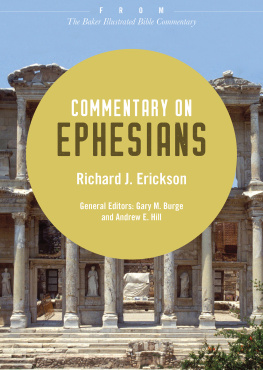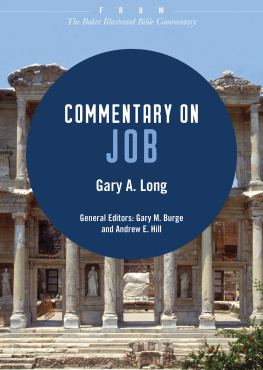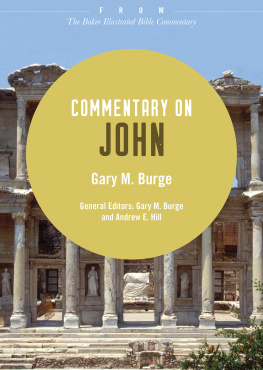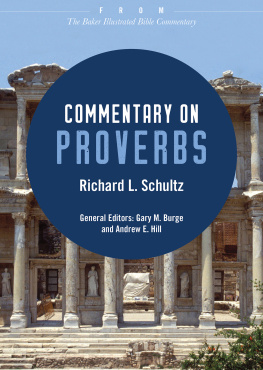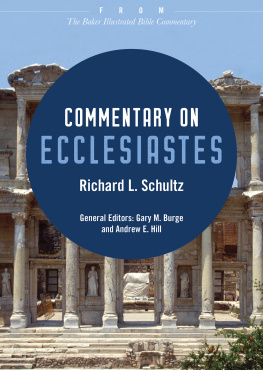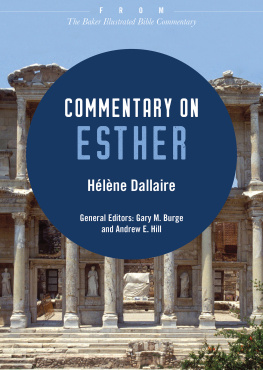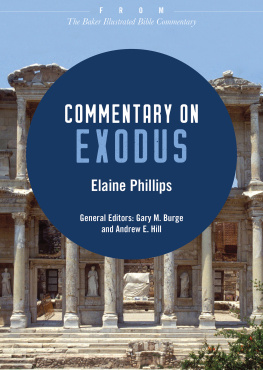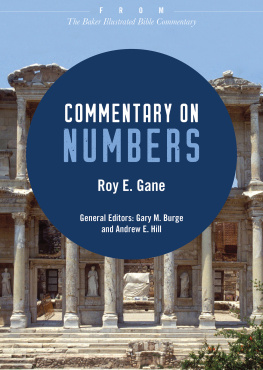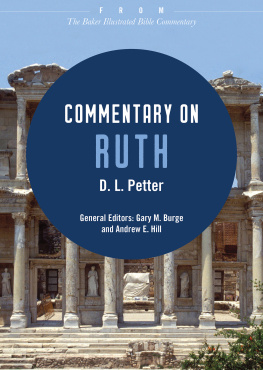Richard J. Erickson - Commentary on Ephesians: From The Baker Illustrated Bible Commentary
Here you can read online Richard J. Erickson - Commentary on Ephesians: From The Baker Illustrated Bible Commentary full text of the book (entire story) in english for free. Download pdf and epub, get meaning, cover and reviews about this ebook. year: 2019, publisher: Baker Publishing Group, genre: Religion. Description of the work, (preface) as well as reviews are available. Best literature library LitArk.com created for fans of good reading and offers a wide selection of genres:
Romance novel
Science fiction
Adventure
Detective
Science
History
Home and family
Prose
Art
Politics
Computer
Non-fiction
Religion
Business
Children
Humor
Choose a favorite category and find really read worthwhile books. Enjoy immersion in the world of imagination, feel the emotions of the characters or learn something new for yourself, make an fascinating discovery.
- Book:Commentary on Ephesians: From The Baker Illustrated Bible Commentary
- Author:
- Publisher:Baker Publishing Group
- Genre:
- Year:2019
- Rating:3 / 5
- Favourites:Add to favourites
- Your mark:
- 60
- 1
- 2
- 3
- 4
- 5
Commentary on Ephesians: From The Baker Illustrated Bible Commentary: summary, description and annotation
We offer to read an annotation, description, summary or preface (depends on what the author of the book "Commentary on Ephesians: From The Baker Illustrated Bible Commentary" wrote himself). If you haven't found the necessary information about the book — write in the comments, we will try to find it.
Commentary on Ephesians: From The Baker Illustrated Bible Commentary — read online for free the complete book (whole text) full work
Below is the text of the book, divided by pages. System saving the place of the last page read, allows you to conveniently read the book "Commentary on Ephesians: From The Baker Illustrated Bible Commentary" online for free, without having to search again every time where you left off. Put a bookmark, and you can go to the page where you finished reading at any time.
Font size:
Interval:
Bookmark:
2012 by Baker Publishing Group
Published by Baker Books
a division of Baker Publishing Group
P.O. Box 6287, Grand Rapids, MI 49516-6287
www.bakerbooks.com
Ebook short created 2019
Previously published in The Baker Illustrated Bible Commentary edited by Gary M. Burge and Andrew E. Hill in 2012
All rights reserved. No part of this publication may be reproduced, stored in a retrieval system, or transmitted in any form or by any meansfor example, electronic, photocopy, recordingwithout the prior written permission of the publisher. The only exception is brief quotations in printed reviews.
Library of Congress Cataloging-in-Publication Data is on file at the Library of Congress, Washington, DC.
ISBN 978-1-4934-2471-9
Unless otherwise indicated, Scripture quotations are from the Holy Bible, New International Version. NIV. Copyright 1973, 1978, 1984, 2011 by Biblica, Inc. Used by permission of Zondervan. All rights reserved worldwide. www.zondervan.com. The NIV and New International Version are trademarks registered in the United States Patent and Trademark Office by Biblica, Inc.
Scripture quotations labeled ESV from The Holy Bible, English Standard Version (ESV), copyright 2001 by Crossway, a publishing ministry of Good News Publishers. Used by permission. All rights reserved. ESV Text Edition: 2007
Scripture quotations labeled NASB are from the New American Standard Bible, copyright 1960, 1962, 1963, 1968, 1971, 1972, 1973, 1975, 1977, 1995 by The Lockman Foundation. Used by permission. www.lockman.org
Scripture quotations labeled NIV 1984 are from the HOLY BIBLE, NEW INTERNATIONAL VERSION. NIV. Copyright 1973, 1978, 1984 by International Bible Society. Used by permission of Zondervan. All rights reserved.
Scripture quotations labeled NJPS are from the New Jewish Publication Society Version 1985 by The Jewish Publication Society. All rights reserved.
Scripture quotations labeled NKJV are from the New King James Version. Copyright 1982 by Thomas Nelson, Inc. Used by permission. All rights reserved.
Scripture quotations labeled NLT are from the Holy Bible , New Living Translation, copyright 1996, 2004, 2007 by Tyndale House. Used by permission of Tyndale House Publishers, Inc., Carol Stream, Illinois 60188. All rights reserved.
Scripture quotations labeled NRSV are from the New Revised Standard Version of the Bible, copyright 1989, by the Division of Christian Education of the National Council of the Churches of Christ in the United States of America. Used by permission. All rights reserved.
Scripture quotations labeled RSV are from the Revised Standard Version of the Bible, copyright 1952 [2nd edition, 1971] by the Division of Christian Education of the National Council of the Churches of Christ in the United States of America. Used by permission. All rights reserved.
Unless otherwise indicated, photos, illustrations, and maps are copyright Baker Photo Archive.
| ANET | Ancient Near Eastern Texts Relating to the Old Testament . Edited by J. B. Pritchard. 3rd ed. Princeton, 1969 |
| BDAG | Bauer, W., F. W. Danker, W. F. Arndt, and F. W. Gingrich. Greek-English Lexicon of the New Testament and Other Early Christian Literature. 3rd ed. Chicago, 1999 |
| ca. | circa (about, approximately) |
| cf. | compare |
| chap(s). | chapter(s) |
| COS | The Context of Scripture . Edited by W. W. Hallo. 3 vols. Leiden, 1997 |
| e.g. | for example |
| ESV | English Standard Version |
| HALOT | Koehler, L., W. Baumgartner, and J. J. Stamm. The Hebrew and Aramaic Lexicon of the Old Testament. Translated and edited under the supervision of M. E. J. Richardson. 5 vols. Leiden, 19942000 |
| HCSB | Holman Christian Standard Bible |
| i.e. | that is |
| KJV | King James Version |
| NASB | New American Standard Bible |
| NEB | New English Bible |
| NET | New English Translation |
| NIV | New International Version (2011 edition) |
| NIV 1984 | New International Version (1984 edition) |
| NJB | New Jerusalem Bible |
| NJPS | The Tanakh: The Holy Scriptures: The New JPS Translation according to the Traditional Hebrew Text |
| NKJV | New King James Version |
| NLT | New Living Translation |
| NRSV | New Revised Standard Version |
| RSV | Revised Standard Version |
| TDOT | Theological Dictionary of the Old Testament . Edited by G. J. Botterweck and H. Ringgren. Translated by J. T. Willis, G. W. Bromiley, and D. E. Green. 8 vols. Grand Rapids, 1974 |
| TNIV | Todays New International Version |
Richard J. Erickson
Introduction
Authorship
Ephesians claims unambiguously to come from Pauls hand, both in the very first word of the letter and in various other personal references. Yet doubts about this arise for several reasons. The authors obviously limited acquaintance with his readers (1:15; 3:2) is highly puzzling if Paul is writing to his friends in Ephesus, where he spent nearly three years. Likewise, the literary relationship between Ephesians and Colossians shows that if the same person did not write both letters at the same time, then one was modeled on the other. But the letters differ markedly in vocabulary and style, suggesting that the same person did not author both documents. Furthermore, the teaching of Ephesians appears in some cases to reflect situations in the early church that postdate Pauls death by several decades (see references to apostles and prophets in 2:20; 3:5). These factors add up to the possibility that Paul did not write Ephesians.
Still, if Paul did write Ephesians, it predates his death in Rome under Nero, around AD 65. References to chains and imprisonment would place composition in the early 60s, probably at Rome. But to whom was it written? Clearly, the author is not well acquainted with the intended readers, which would be strange if they were Pauls congregation at Ephesus. Oddly, certain important and early Greek manuscripts lack the words in Ephesus (1:1), suggesting that the document was never meant for that congregation, but for some other or others that Paul had never visited. Perhaps it was a circular letter sent to several churches in Roman Asia, including Ephesus. At any rate, the real destination (if not Ephesus) and the origin of the insertion in Ephesus remain conjectural.
Taken one by one, the separate pieces of evidence against Pauline authorship can perhaps be explained away. Their cumulative effect is what carries the greatest weight against authenticity. The evidence is not airtight either way. Objections to the inspired lie perpetrated by another authors calling himself Paul dismiss the idea that pseudepigraphy may have functioned in the first century like footnoting does today. We may then with good conscience treat Ephesians either as written by Paul or as written by one of his associates. Meanwhile, for simplicitys sake, we can refer to the author as Paul.

Content
Central to the message of Ephesians is Gods re-creation of the human family according to his originally intended design. This new creation shatters the Jewish communitys long-standing opinion that God accepts Jews and rejects non-Jews. The traditional criterion of distinction between the Jew and the non-Jew is obedience to the law, but this criterion, fostering pride and exclusivism, was abolished in Christs sacrificial death. Consequently, nothing hinders reuniting all humanity as the people of God, with Christ as the head. The fact that even within the church, let alone outside the church, this reunification is not fully in effect is the result of the advance arrival of the new age of Gods rule. Even now God endows his new family with the power of the Spirit, enabling them to live out here and now their future new life. Thus Ephesians focuses on Gods people united in Christ through the power of the Spirit.
Font size:
Interval:
Bookmark:
Similar books «Commentary on Ephesians: From The Baker Illustrated Bible Commentary»
Look at similar books to Commentary on Ephesians: From The Baker Illustrated Bible Commentary. We have selected literature similar in name and meaning in the hope of providing readers with more options to find new, interesting, not yet read works.
Discussion, reviews of the book Commentary on Ephesians: From The Baker Illustrated Bible Commentary and just readers' own opinions. Leave your comments, write what you think about the work, its meaning or the main characters. Specify what exactly you liked and what you didn't like, and why you think so.

